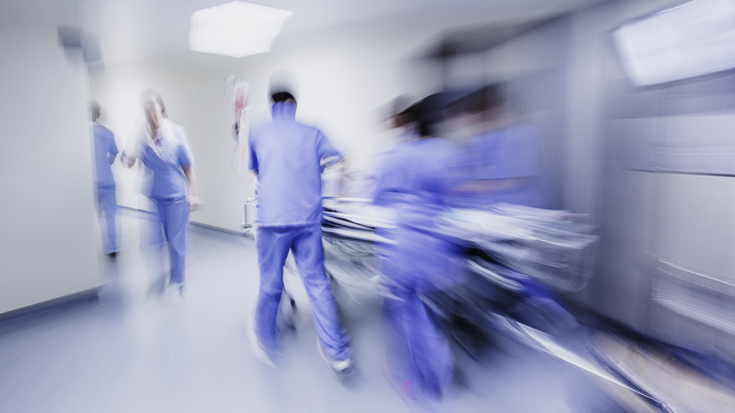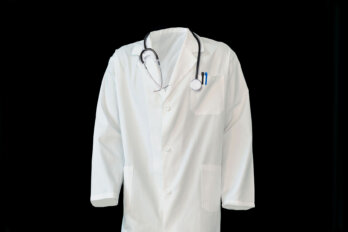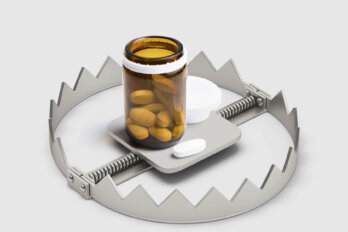In the early spring of 2020, in downtown Toronto, a man was stabbed in the chest. Ambulance bay doors crashed open as paramedics rushed the patient into St. Michael’s Hospital. Within seconds of his arrival, he was inside the trauma bay, unconscious and bleeding internally, a team of roughly a dozen medical professionals converging on him. Then his heart stopped.
At the head of the patient’s bed, the anaesthesia crew carefully slid a breathing tube into his airway while two nurses placed a pair of IVs in his arms. On the patient’s right, a team member inserted a tube to drain the blood filling his lungs. On his left, a doctor opened his chest, found the hole in his heart, and sealed it—a rare procedure that must be finished within a few minutes or the patient’s chance of survival is extinguished.
In some ways, a trauma bay is a machine, a complex system with many moving parts. Approximately 800 trauma patients arrive at St. Michael’s every year, each case unique and unpredictable, but the goal is always the same: stabilize the patient as quickly as possible before they are whisked off to surgery or intensive care. The work of trauma medicine, however, is performed by humans, and this presents the system’s biggest challenge. “As soon as you have someone on the table who might die, your brain can go into a fog,” says Jasmine Errett, a registered nurse at St. Michael’s. “Your nursing skills can wash away with the high emotion.”
The stakes make it both easy to misstep and vital to not. When the system runs smoothly, the results can feel miraculous. In the case of the man stabbed in the chest, the trauma team was able to buy the patient enough time to be rushed down the hall, into the elevator, and up to the operating room. Days later, he was discharged from the ICU. Weeks later, he went home.
Although the success of this case is outstanding, it was not a fluke. It resulted from myriad factors: the trauma team’s decades of combined training, its flawless execution under extreme pressure, and its environment, the trauma bay—an often overlooked aspect of emergency medicine to which particular attention had recently been paid at St. Michael’s.
Years earlier, physicians Christopher Hicks and Andrew Petrosoniak, both St. Michael’s trauma-team leaders, noticed that, when things went sideways in a resuscitation, it was almost never because the medical professionals involved didn’t know what to do. Rather, they often lacked the adequate tools, space, or communication frameworks to perform the split-second, lifesaving feats on which trauma medicine depends. In the past, you might find central line equipment or a Foley catheter kit on a patient’s gurney during chest compressions because there was no other workspace. Staff often dragged in bedside tables from other rooms to gain a few inches of countertop workspace. A lack of intentional design in hospitals, combined with the gradual addition of new technology, equipment, and protocols, resulted in a piecemeal approach—making the trauma room feel more like a puzzle than a space where lifesaving work should happen.
One of the biggest problems, according to Hicks, was a workplace culture that prized the ability to adapt to difficult working conditions over innovation to improve those conditions. Doing things the hard way—improvising when a certain type of bandage or suture is missing from the supply cart or MacGyvering a solution when a tool is broken—is often viewed as a badge of honour among emergency department staff. “The learned helplessness that I saw in health care really bugged me,” says Hicks. “So I applied the advice to take something that bugs you and make it your project.”
In 2015, determined to make a dent in the problem, Hicks and Petrosoniak teamed up for a research project that would have far-reaching results. The goal was to identify and remove the latent hazards and obstacles that cost trauma staff precious seconds in dire situations. “You cannot remove the stress of someone dying in front of you,” Petrosoniak says. “But we can remove the stress of not being able to find equipment.” When lives are on the line, it’s not enough for emergency staff to be highly skilled: they must be set up for success.
During the Second World War, a disturbing trend arose among the Royal Canadian Air Force pilots. Thousands of flyers—including trainees, graduated pilots, and flying instructors—were falling from the sky in perfectly operational planes. From 1942 to 1944, at least a dozen pilots and crew members died every week on Canadian soil. At first, these accidents were attributed solely to operator error. Then Alphonse Chapanis, an American industrial designer considered to be the founder of aviation psychology, identified a key factor: two identical, side-by-side switches—one for the landing gear, one for the wing flaps. Exhausted by long flights or distracted by the array of other demands on their attention, pilots were flipping the wrong one, with disastrous results.
Once these switches were given different shapes, the crashes stopped. The problem had little to do with the pilots or their training. Instead, it came down to how human operators were interacting with a complex system. It simply wasn’t easy to do the right thing every time, and this contributed to thousands of accidental deaths over the course of the war.
The principle identified by this case went beyond moving a few switches. Ever since, every aspect of the cockpit has been scrutinized to limit accidents—the placement of buttons, the order of checklists, and even the way team members speak to one another. Aviation’s overhaul now serves as a template for many other industries, including health care.
In a field as complicated as trauma medicine, the potential for mistakes abounds: a missing instrument, a mislabelled bag, a patient in distress, a new team member, a doctor being too far from the trauma room when paged. These are the kinds of hazards that wait in the shadows, often unnoticed, but can combine quickly to create a catastrophe. Hicks and Petrosoniak wanted to identify these possible hazards within their own work environment so they could manage or eliminate them.
To do so, from July 2015 to June 2016, the duo ran twelve simulations, inviting human-factors researchers Patricia Trbovich and Mark Fan, from the patient safety and quality improvement department at the University of Toronto and North York General Hospital, to observe. Trbovich and Fan’s research involves investigating how workers interact with systems. To begin each scenario, an overhead page alerted the trauma team of an incoming patient. Only when the team arrived did it find out that the case was a simulation. The scenarios were based on real patients and used a combination of mannequins and hired actors. After each one, a debriefing encouraged feedback from all team members.
The deeper work began when Trbovich and Fan watched the videos, each time observing the simulation from a different participant’s viewpoint. They kept an eye on potential safety hazards and then grouped these into themes, such as physical workspace, communication issues regarding responsibility or accountability, and equipment and supplies. They released their findings in BMJ Quality and Safety, published by the British Medical Journal, nicknaming it the TRUST study (short for trauma resuscitation using in situ simulation team training).
Armed with detailed feedback and data, Hicks and Petrosoniak set out to optimize their department: clearing two metres of space around each bed for adequate elbow room while performing tricky procedures, adjusting how the lights hung on the overhead booms so physicians could best see into wounds, and increasing the visibility of vital-sign monitors so every team member could easily see a patient’s heart rate spiking or blood pressure bottoming out. Carts containing airway equipment were standardized and colour coded, huge stickers were placed on the floor to identify where team members should stand, and signs reminded staff to don PPE before entering the room.
The new St. Michael’s trauma bay opened in January 2020. And, while the team is still collecting statistics—the COVID-19 pandemic has complicated the process—Hicks and Petrosoniak report that even the first months saw some dramatic rescues that would have been much more difficult in the old space. Now, after a period of adapting to this new way of operating, the whole staff is on board. “The funny thing about design is that, when it works well, no one says anything,” says Petrosoniak. “The absence of frustration means that the design is working well.”
Thoughtful changes to a physical workspace are a good start, but they address only half the equation. The more complex part of human-factors research tends to be the human. As medical science and technology gallop ahead, basic interpersonal communication remains one of the stickiest challenges of the trauma bay. Decades of ingrained hierarchy—with doctors being viewed as unassailable—have left a mark. Errett recalls an incident early in her career when she was told to transport a very sick patient to the CT scanner for urgent imaging. She didn’t think it was the right choice—the patient’s airway seemed too unstable to leave the supplies and professionals needed if it collapsed and cut off the patient’s air supply. But, because there was no mechanism for her to raise her concern without stepping out of line and questioning the trauma physician, Errett reluctantly wheeled the patient out of the trauma bay. Within minutes, the patient stopped breathing.
Despite some progress, trauma medicine is still struggling to overcome its communication challenges, attempting to establish precise language, flatten the hierarchy, and empower all staff members to speak up. In Trbovich’s research, when she discusses the importance of speaking up—especially as staff identify latent hazards—she often gets the same response from trauma staff: “How exactly am I supposed to do that?”
At St. Michael’s, scripted communication and checklists are being used to address this. Long-time nurse Mark Joithe notes that communication is becoming more standardized, making it easier to raise concerns, respond to orders, and stick within his role. “It is more choreographed, more scripted, more disciplined,” he says. “It feels more scientific now.”
At the same time, designated pauses for communication are being carved out of the often hectic workflow. Before a patient leaves the trauma room, the team now stops to run through a list of questions: Does the patient need medication before being transported? Was the family contacted? Was the patient’s temperature documented? Perhaps the most important question is the most open ended: Does anyone in the team have any other concerns? This wouldn’t have been asked until recently, and it provides an opportunity for team members—any team members—to speak up.
Flattening the medical hierarchy also means encouraging team leaders to admit when they’re in the weeds. It may seem counterintuitive, but Trbovich reports that, when a clinician says out loud to the team that they are unsure of the diagnosis or the next step, the team performs better. At a recent workshop for seasoned trauma physicians, however, Trbovich noted that they still didn’t feel comfortable speaking up when they were having trouble. When your career entails the lives of others being put in your hands, fallibility can be a difficult thing to admit.
Overall, St. Michael’s trauma redesign has been a success. But expanding this success into a system-wide overhaul is stymied by the lack of communication between hospitals across Canada. According to Hicks and Petrosoniak, precious few other hospitals are doing in situ simulations and incorporating human-factors research into their designs and processes. “When you step into our trauma bay,” says Hicks, “you’re stepping into an environment that doesn’t exist anywhere else.”
In an effort to popularize these innovations, Hicks and Petrosoniak are sharing their knowledge via academic publications and conferences. Their efforts are getting noticed: the pair receives regular requests from hospitals nationwide—from departments including ICU, pediatrics, interventional radiology, and cardiology—looking to spark change in their workplaces. To better address these requests, the physicians formed the company Advanced Performance. Inquiries are still pouring in, stretching their consulting abilities thin and raising the question: Why aren’t provincial health departments supporting and coordinating this work?
When asked about the province’s involvement (or lack thereof) in the effort to redesign emergency facilities, a spokesperson from the Ontario Ministry of Health responded that, while “the ministry reviews all physical designs and service delivery models to ensure legislative and best practices standards are reflected throughout the planning process,” each individual hospital “is responsible for delivering and evaluating a design that optimizes care delivery.”
For Hicks, putting the onus on hospitals is a missed opportunity. “Our hunch is that health systems don’t know that this piece is missing and thus aren’t looking for a solution,” he says. He also notes that health administrators are not typically systems experts—they generally aren’t well versed in hazard prevention, he says, and can be averse to innovation when it presents new costs. “It’s a big gap in quality of care that nobody seems all that interested in filling.”
For many who staff these institutions, big ideas such as human-factors research are often forced to take a back seat. After all, the next patient is on the way, a split-second decision between life and death. Duty calls.





